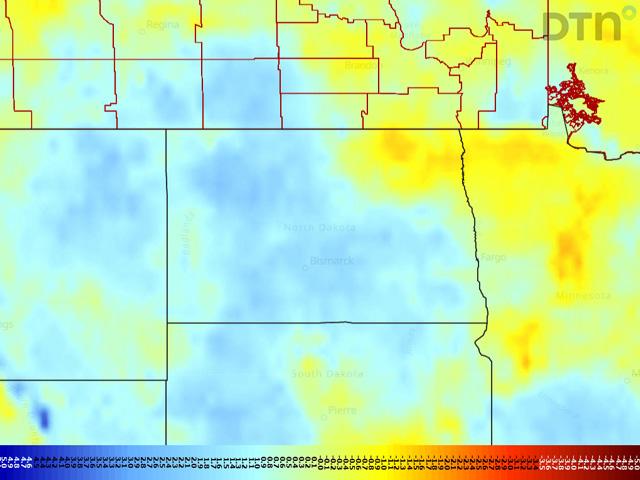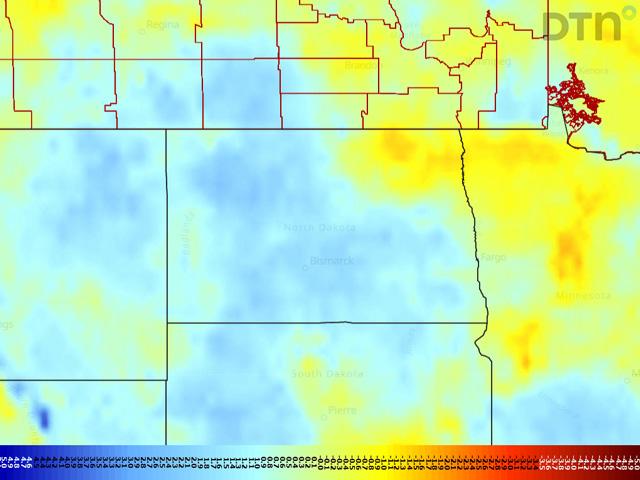Ag Weather Forum
North Dakota Planting Progress Mirrors 2022, So Far
Scanning Monday's Crop Progress report from the USDA shows us that corn and soybean planting pace slowed slightly, but remains faster than average and certainly last year. And though behind the average pace, spring wheat planting has really picked up during the last week as well. All except for one state: North Dakota.
It is the only state on the report that is behind the average planting pace for corn, soybeans, and spring wheat by double digits, mirroring the slow progress to this point in the 2022 season. Planting progress for corn sits at 5% (4% last year, 26% average), soybeans at 2% (2% last year, 15% average), and spring wheat at 20% (16% last year, 46% average).
Much like 2022, spring in the Northern Plains, and North Dakota in particular, was awfully cold and wet. Air temperatures only recently came up above normal in late April and early May, with soil temperatures lagging well behind. Snowpack stuck around through much of April, flooded the Red River Valley, and additional heavy rain last week slowed progress as well. Much of the state has above-normal topsoil moisture at the moment, which is fine for those with seed in the ground, but more difficult to pick up the pace. There is still some ponding needing to be worked out.
P[L1] D[0x0] M[300x250] OOP[F] ADUNIT[] T[]
This year differs from last year in that May 2023 is much warmer. Temperatures in May 2022 were below normal for most of the state, keeping moisture in the soil longer and causing soil temperatures to rise only slowly and sporadically. It was also a wetter month, especially for the eastern half of the state, adding additional moisture to the profile.
While last week's rainfall certainly added to the soil column as well, temperatures this year have been above normal, helping to work more of the water through the system and warm soils faster. That higher temperature trend is forecast to continue for the second half of May, with above-normal temperatures expected with only a few cooler days mixed in. Precipitation should also trend lower for the rest of the month, though not completely dry. A front will bring scattered showers through May 17-18, but amounts will be light, less than 0.25 inch expected for most areas. Some additional showers may be possible next week, but models are not too keen on having anything widespread or heavy across much of the state. Farther west toward the Rockies stands a better chance at that.
The slower progress to date then, should not be overly concerning either for traders in grain markets, or farmers and ranchers in the state. Conditions for planting should only increase for the rest of the month. Significant delays that we saw in 2022 deep into June are not expected to repeat themselves in 2023. And the over 2 million acres that went to prevent plant in 2022 is unlikely to be matched for 2023.
For more information on how the summer weather will turn out not just in North Dakota but across the country, register for the upcoming DTN Ag Summit Series event, "Crop Updates from the Field." We will visit with farmers from across the country, talk about the latest dicamba and pesticide news and discuss DTN's latest weather and market outlooks. The program begins Tuesday, May 23, at 8:30 a.m. CDT. We understand if you're too busy to attend live. It will be available for replay; however, you must register before the May 22 deadline to gain access. Registration is free, and you can find more details here: www.dtn.com/agsummit.
To find more weather conditions and your local forecast from DTN, head over to https://www.dtnpf.com/…
John Baranick can be reached at john.baranick@dtn.com
(c) Copyright 2023 DTN, LLC. All rights reserved.






Comments
To comment, please Log In or Join our Community .